INTRODUCTION
His early life unfolded like
a story
co-authored by Dickens and Darwin. As an infant, he was taken from
his mother and sold out of an orange crate for $25 and a
thumbprint. He was carried across an ocean, installed inside a cage,
and taught to depend on the imperfect love of strangers. Although he was
afforded the privileges conferred by rank, he never chose a mate. He had
no interest in females of his own kind; instead, he preferred blondes in tank tops.
Altogether he lived at Lowry Park Zoo for 35 years, lasting longer there
than any other creature and longer than any of the employees. Each of the
1,800 animals at the zoo is assigned a number. Herman's was 00001.
|
|
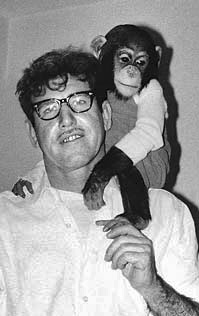 EARLY
LIFE EARLY
LIFE
Born in 1966 in Liberia, West Africa, he was only an infant when a poacher in the West African
bush took him from his parents, killing his mother for meat. He almost certainly saw her die trying to protect
him. In December of the same year, an American named Ed Schultz, working for an iron-ore
mining company in the west African port of Buchanan, heard that someone at
the mess hall was selling baby chimps.
Ed & Herman, late 1960s
St. Pete Times Photo "Zoo Story - Code 1"
|
 |
|
He found the man waiting with an open orange crate. Inside were two
chimps, each only a few weeks old. They looked up at Schultz and
reached up with both arms. "You're my Herman," said Schultz,
scooping up one of the chimps. He didn't know where the name came
from. It just seemed right. Schultz paid $25 in cash, got a receipt
marked with a thumbprint -- the seller didn't know how to write --
then took Herman home to meet his wife Elizabeth and children Roger
and Sandy.
|
|
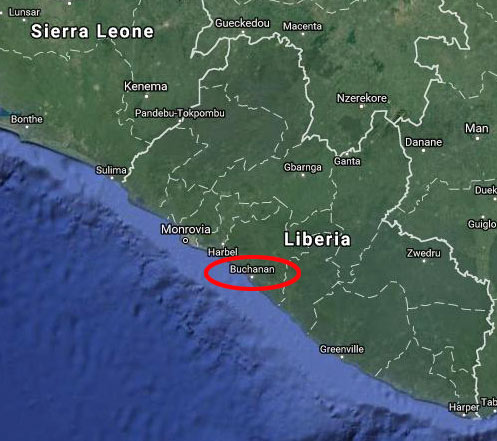 |
 |
See recent photos of Buchanan, Liberia, at + Encyclopedia where photos
below are from.
|
 |
 |
|
Grand
Bassa County Police Station, Buchanan
Buchanan is the capital of Grand Bassa Co. |
Spark's
Hotel, Buchanan, Liberia |
|
At first
the Schultzes fed Herman from a
baby doll bottle, put him in diapers, and then taught him to eat his fruit
and drink from a cup at the dinner table. The family adored and
pampered him, not having any idea all the ways their love would
change him.
GITTA JOINS THE
SCHULTZES |
|
A
few months later, they started caring for another young chimp, a female
named Gitta. Before she came to the Schultz home, Gitta had
been confined almost exclusively to a small cage and was extremely shy and
unsure of herself around humans. When she saw Herman, she clung to
him and rocked nervously back and forth. Herman tolerated her
neediness; even then, he seemed more patient then other chimps.
|
As
the Schultz children grew, their parents would mark their changing height
on the wall. As Herman and Gitta grew, height marks were made for them,
too. "He was probably as close to a human as a chimp could be," Roger
Schultz, Ed's son, said of Herman. "I don't think he really believed he
was a chimp." Naturally affectionate and overflowing with personality,
Herman featured more prominently in the Schultzes' daily lives.
|
|
HERMAN'S ATTRACTION TO BLONDES
LAMCO, the iron-ore company where Ed
worked in Liberia, employed people from around the world, including an
abundance from Sweden. At parties and company picnics, Herman -- young,
impressionable and decidedly male -- was constantly being swept up in the
arms of Swedish women. Ed's wife, Elizabeth, was a blonde, as well as the
Dutch girls who came to their home. Herman grew up surrounded by
fair-haired women who showered him with attention. It is no wonder that
Herman had a weakness for blondes.
The Schultz family
hoped Herman would eventually mate with Gitta, but it never happened. Though he
was friendly to Gitta and other female chimps, his libido had already been
turned from his own kind. Believing they had saved Herman, they
embraced him into their lives without realizing what that embrace would
mean.
COMING TO AMERICA
In late 1967, Ed found a
job in the U.S. and the Schultzes headed back to the states. They
settled in Ohio, and Ed arranged to have Herman and Gitta join them there.
On their first Christmas, they dressed Herman in a knitted cap and
booties and carried him outside to play in the snow drifting across their lawn.
|
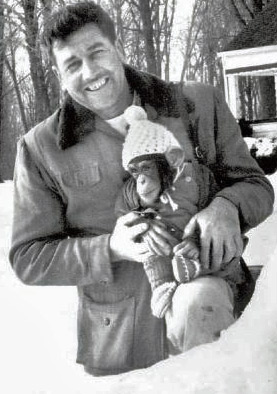 |
| |
St. Pete Times, FLORIDIAN Section E. Dec. 6, 2007 - Zoo Story -
Life. Death. The Paradox of Freedom,
Ch. 3 - Imperfect Love |
|
TAMPA AND LOWRY PARK ZOO
Soon, Ed took a job as a manager at
a phosphate company in Tampa. Ed and his family, including Herman and
Gitta, moved here. The chimps were then 5 years old and on the verge
of chimp adolescence. They were getting larger and stronger, and more
difficult to control--to the point where Ed's wife and daughter were no
longer comfortable taking them into the house on their own. "A
chimp at 8 years old can take your finger right off with his teeth,"
Schultz said.
So in 1971, after looking for a new
home for Herman and Gitta, Ed decided to donate them to Lowry Park
Zoo, which at the time was run by the city of Tampa. In exchange,
the family made two requests: that Herman and Gitta be allowed to live out
the rest of their lives at the zoo, without being sold or transferred to
another facility and possibly end up in some research lab. The second
request was that in the off-chance Herman and Gitta were ever to mate, the
Schultzes were to be given custody of the offspring. In those days,
Lowry Park had a reputation as a stark and sometimes even grim place, and
they wanted to make sure their offspring would be well cared for, having
no confidence that the zoo was up to the task. Still, to Ed, Lowry
Park seemed like the best choice for his chimps. The zoo was ready to give
Herman and Gitta a cage of their own, larger than the one they were kept
in with the Schultzes. They had also agreed to let Ed and his family visit
and hold them if they still felt safe enough to get close.
|
|
On
the day of the big move, the Schultz family drove the chimps to
downtown Tampa for a ceremonial visit at City Hall.
 Tampa newspaper photographers took pictures of Mayor Dick
Greco hamming it up with the chimps. One shot showed them seated beside
Greco, pondering the city budget. The staged frivolity didn't take
away the bittersweet emotions of the day, but the Schultzes were pleased
to see Herman reveling in the spotlight. That day, as he posed for
the news crew, he was being trained to perform for a larger audience.
For better or worse, he was about to become a star. Tampa newspaper photographers took pictures of Mayor Dick
Greco hamming it up with the chimps. One shot showed them seated beside
Greco, pondering the city budget. The staged frivolity didn't take
away the bittersweet emotions of the day, but the Schultzes were pleased
to see Herman reveling in the spotlight. That day, as he posed for
the news crew, he was being trained to perform for a larger audience.
For better or worse, he was about to become a star.
As they
escorted Herman
and Gitta to
their new home, on the way in to the zoo, Herman climbed a light pole. After a childhood in
the trees, it was the last time he would have a chance to climb anything that
tall.
The Schultz family climbed into his cage with him to
say goodbye. Then, with he children crying and their parents heartbroken, the
cage door was locked shut and Herman began his third life.
Herman
stayed in the old zoo for the next 16 years. It was awful. Tens of thousands of
people filed past, often too close for the animals’ safety.
|
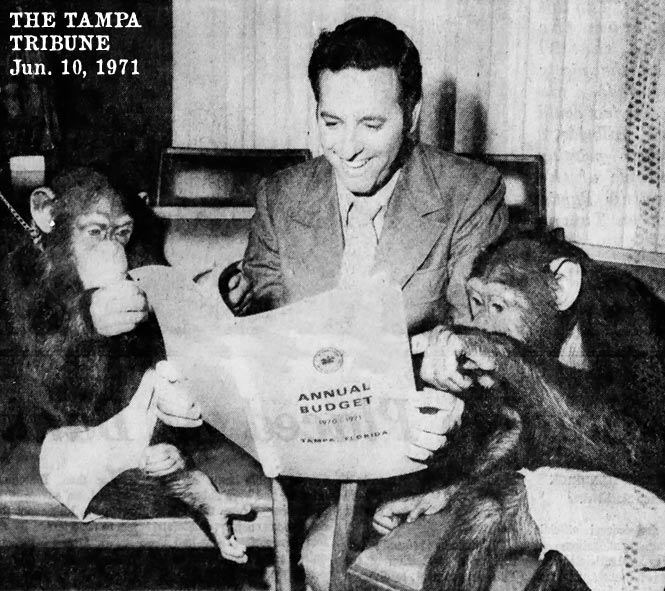
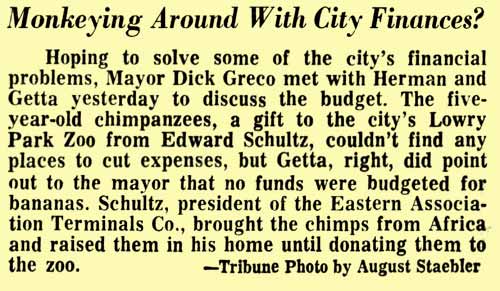 |
PROBABLY HERMAN
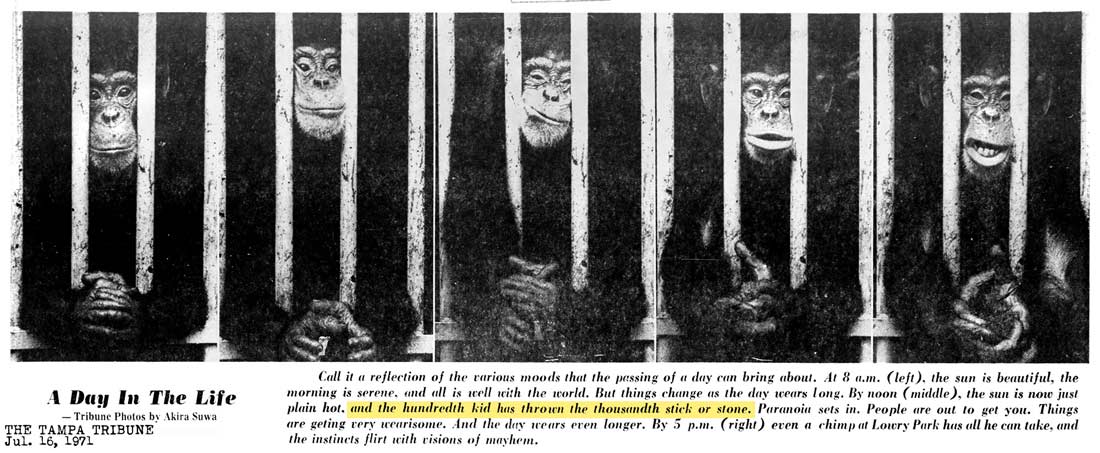
|
|
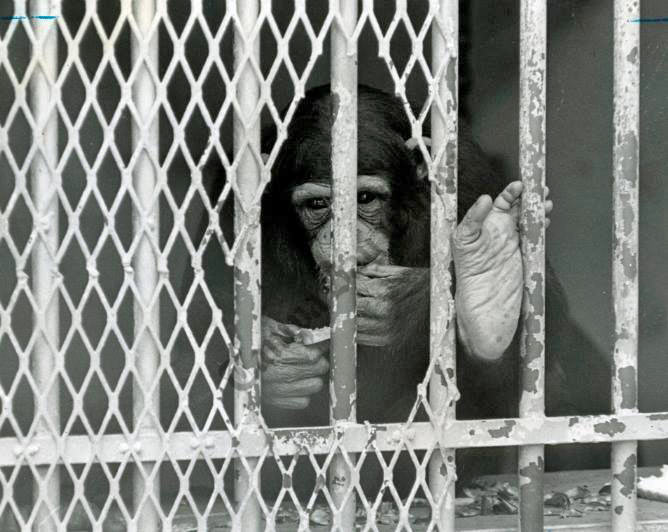
TBT
Photo, 1972 |
News clips from over the decades tell a harrowing story: Razor blades
tossed into dilapidated cages, arrows shot into the compounds. The place was
deadly. Sea lions collapsed from copper poisoning after eating pennies that had
been tossed into their tank. A tiger died after someone gave it amphetamines and
barbiturates.
First he had clung to his
mother in the forest, then he had been adopted by his human family. Now he
was on display for a never-ending parade of new faces. Mostly, though,
Herman was known for his relatively benign temperament.
When Jane Goodall
visited in 1987, she fell for him instantly, praising his glossy coat,
pleasant personality and the "lovely open expression on his face."
Inside his cage, Herman learned to perform, to clap and
blow kisses and smoke cigarettes. Whatever it took to win over the strangers who
came to see him.
|
|
About the above photo,
described by former Lowry Park Zoo director Doug Porter:
That long-ago article also featured another individual, a
youngster named Herman. He was just a little guy – about six years
old – and he did not deserve to be behind bars. A photo of him in
the article evokes a sense of despair even though he appears
relaxed with one foot propped up on the bars as he picks intently
at a piece of fruit. He had only been in those cramped, dank
quarters for about a year, but the real tragedy was that he would
live there for another twelve years before our paths would cross
again and I would be privileged take over that zoo and to do
something about his condition. Herman was a Chimpanzee who lived
across town in what the article described
as the “dilapidated, prison-like cages” at the other zoo in town.
His discomfort was uncomfortably evident.
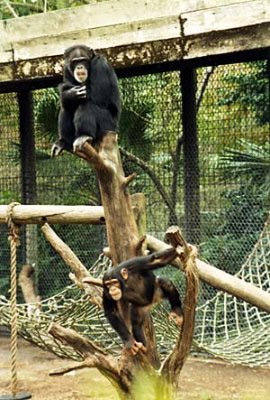 Twelve
years after the newspaper article that linked us, Herman and I
would cross paths again when a master plan called for a new zoo,
and I was hired to guide the process. For nearly three years,
workers poured concrete, sculpted artificial rocks, and installed
caging until we were planting grass, testing waterfalls, and
moving animals into their new homes. The new chimpanzee area was
not especially large, but it was an interesting and varied space
for animals who had only known concrete and chain-link. A long,
grassy yard was broken up by large logs and an artificial,
concrete termite mound. A deep dry-moat barrier afforded the
chimps an unobstructed view of their human visitors and the
landscape beyond. One of the highlights of my zoo career was
seeing Herman walk on grass for the first time and climb atop his
favorite perch on the termite mound to gaze back at me. I am not
suggesting that he was actually “happy” but I do know that I did
everything in my power to make him so. Twelve
years after the newspaper article that linked us, Herman and I
would cross paths again when a master plan called for a new zoo,
and I was hired to guide the process. For nearly three years,
workers poured concrete, sculpted artificial rocks, and installed
caging until we were planting grass, testing waterfalls, and
moving animals into their new homes. The new chimpanzee area was
not especially large, but it was an interesting and varied space
for animals who had only known concrete and chain-link. A long,
grassy yard was broken up by large logs and an artificial,
concrete termite mound. A deep dry-moat barrier afforded the
chimps an unobstructed view of their human visitors and the
landscape beyond. One of the highlights of my zoo career was
seeing Herman walk on grass for the first time and climb atop his
favorite perch on the termite mound to gaze back at me. I am not
suggesting that he was actually “happy” but I do know that I did
everything in my power to make him so.
Photo from Doug Porter's "This Place is a Zoo" Ch. 5
THIS WAS PROBABLY HERMAN AND GITTA
Notice the shape of the opening of the wire grating compared to
photo above.
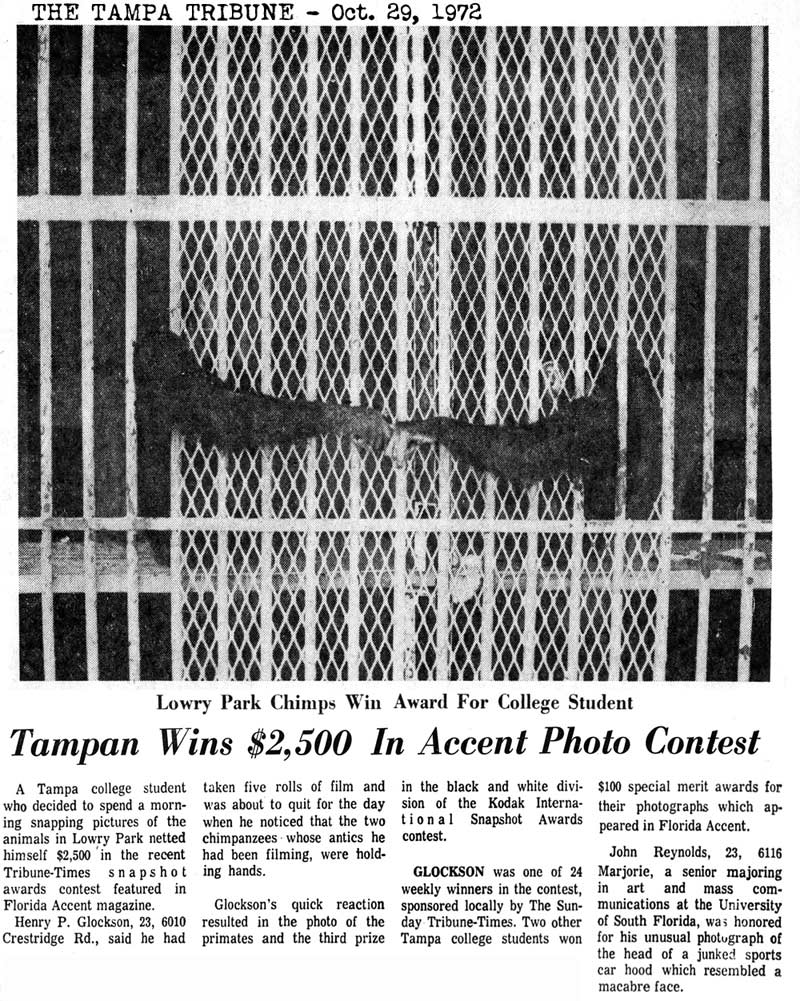
A LETTER TO THE TRIB FROM ED
SCHULTZ, HERMAN & GITTA'S ORIGINAL OWNER
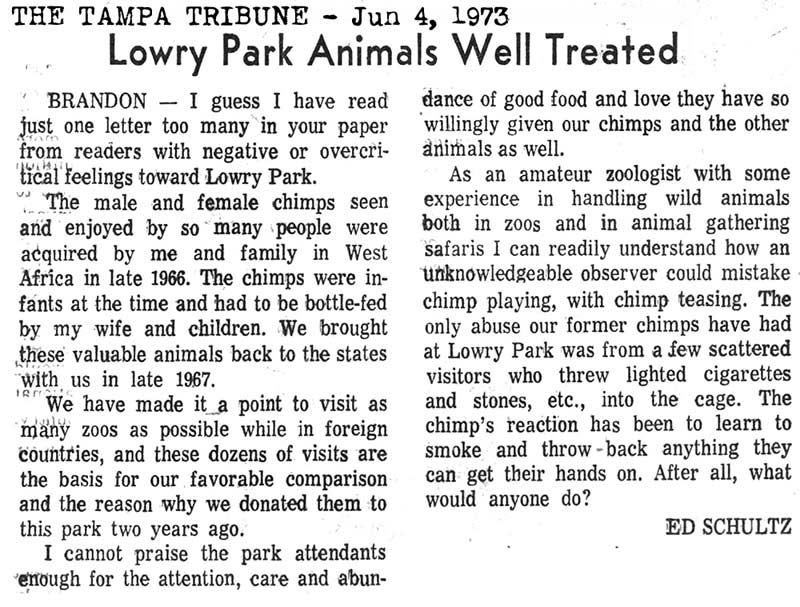
|
|
HERMAN LOSES GITTA
Herman saw many
changes.
He lost his closest companion when Gitta died of a viral infection in Feb.
1987. By then, the zoo was reinventing itself. Somehow, he survived long enough to see the old Lowry Park torn
down and the rebuilding of the Zoo to create more
natural exhibits. His home inside the new zoo — the exhibit with the artificial
rocks and waterfall — was hardly a substitute for the life he might have
led in Africa. But it was a considerable improvement over the cage,
allowing enough room not just for Herman but for a small group of other
chimps.
If one of the other chimps in his
group was upset, he offered comfort. If a dispute erupted, he stepped in.
Often, though he held himself apart from the others and stayed on his
stony perch. His early years with a human family had left him in
profound confusion, and his years of isolation in the cage had increased
this confusion and imbued him with an unceasing need for human attention.
|
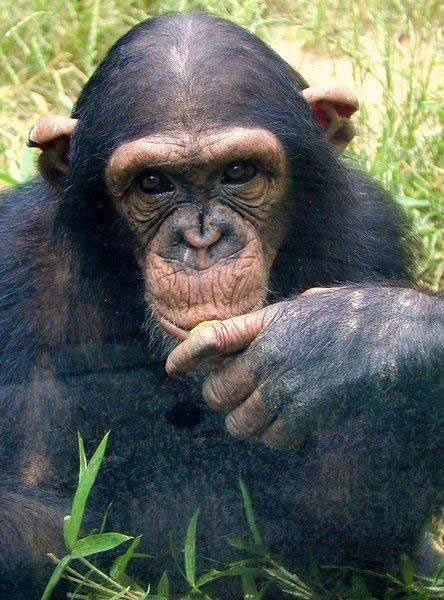 |
| |
Zoo Story – Home is Where the Boat Is.net
- Sept. 2010 |
|
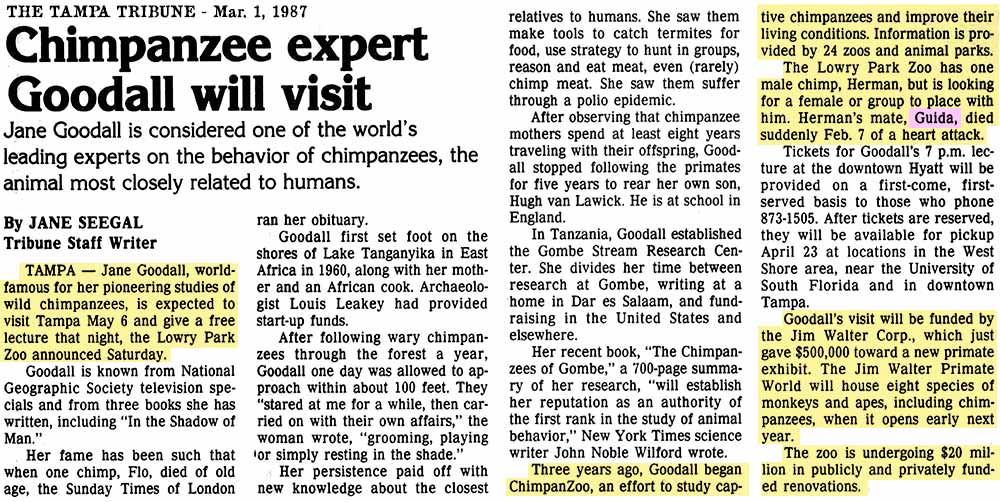
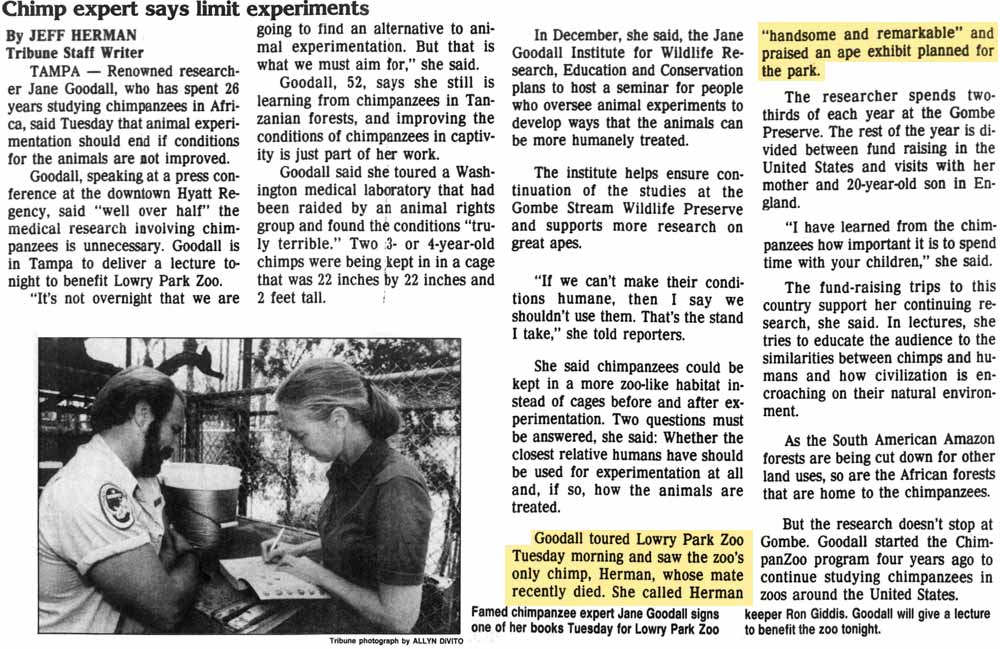 |
|
|
|
THE NEW ZOO YEARS
Waves of primate keepers worked with Herman since
the new zoo opened in 1988, and as they have all come and gone, the king stayed. He was the zoo’s most famous resident for over 3 decades;
many of the keepers with him
at the time weren’t even born when he arrived at Lowry
Park. Herman’s gentle disposition made him a favorite among both Zoo
guests and animal care staff alike.
Even though his alpha status in the group gave him sexual
privileges, he never tried to breed with the three female chimps
available to him. Instead he was attracted only to human females,
preferably athletic blondes. At times, Herman seemed uncannily
human, understanding things that eluded the other chimps. His
unusual relationship with Dr. Murphy was a good example. Like many
of the animals at Lowry Park, most of the chimps disliked the
veterinarian. One day, Murphy appeared in the chimp night house with
a tranquilizer gun so he could attend Herman, Murphy was a good shot
and almost never missed. But this time, his aim was off. The other
chimps would have run and hid. Herman just picked up the dart,
walked over to the mesh, and handed it back to Murphy so he could
try again.
|
Herman survived by using his skills as an entertainer.
He learned to flirt and blow kisses, to clap and dance and turn
somersaults; anything to delight the crowds. When people
tossed him lit cigarettes, he would smoke for them. Other
chimps, when bored or upset, will throw their droppings.
Herman was fastidious about his bodily functions after growing up
in diapers--he would not touch his waste. Instead, Herman
would throw dirt. Even Mayor Greco was not immune to being a
target. In 1972, a year after Herman arrived at Lowry Park,
the zoo's appalling conditions had drawn the attention of the
National Humane Society. A representative inspected the
facility, accompanied by Mayor Greco. As they neared
Herman's cage, they saw him pick up a handful of dirt.
Drawing closer, Greco said, "I want to see if he'll throw it."
Always obliging, Herman hurled away. Herman had a remarkable
ability to recall faces, or possibly even to sense a person's
powerful position and reputation.
(Zoo Story, by
Thomas French - Chapter 5 "Royalty")
|
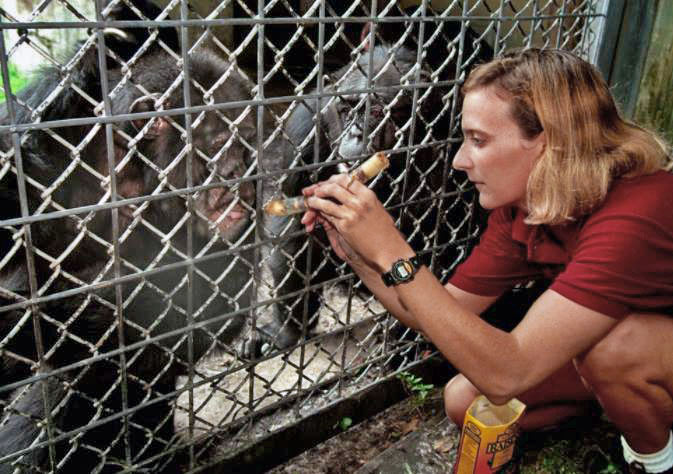
Sept. 5, 1995 - Tampa -
Lee Ann Rottman, a zookeeper at the Lowry Park Zoo, gives some
chimps (probably Herman) a snack. She is going to Uganda,
Africa to study chimps that have been released on Isinga Island in
the Queen Elizabeth National Park. Tampa Bay Times archives
photo courtesy of Kimi Lau-Costanzo.
|
|
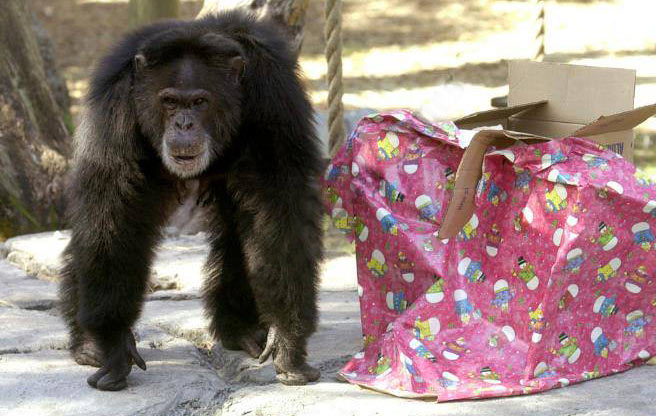 |
Herman enjoys a Christmas
gift of edible snacks during Presents for Primates at Lowry Park Zoo
in Tampa in 2001. TBT photo.
|
HERMAN
TURNS 40
In the spring of 2006, as he neared
his 40th birthday, Herman's chin hair was turning silver. He was getting
older. In captivity, chimps can live to be 55. Herman had slowed down a
little. But he still displayed for his fans, stomping around and bristling
his hair to make himself look bigger. He still flirted with blondes. Ed
Schultz, Herman's old friend, still came to see him. Schultz had retired
years before and now worked as a
docent
at the zoo. |
|
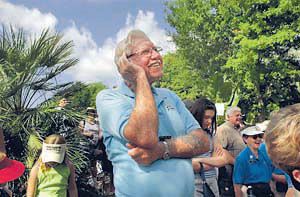
Herman watched the approach of a tall man from his perch. He didn't
know the man's name, but he recognized him. The old man with the
thick white hair and weathered face stood at the edge of the chimp
exhibit and grinned. Herman saw him and rocked his body and raised
his arm in greeting. "That's my son", said Ed Schultz, turning to
any visitors that would listen to him - some 35 years had passed
since Ed and his family had brought Herman to Lowry Park. Ed was 91
now and hanging on the best he could. Ed still lived in Tampa, and
his favorite pastime was going to see Herman and telling stories
about their lives together. Herman felt a deep connection to Ed, and
the zookeepers noticed an edge of desperation in Herman, especially
when his visits ended. Sometimes the zookeepers wished he wouldn't
visit so often; because every time Ed walked away, it seemed to leave
Herman shaken and upset |
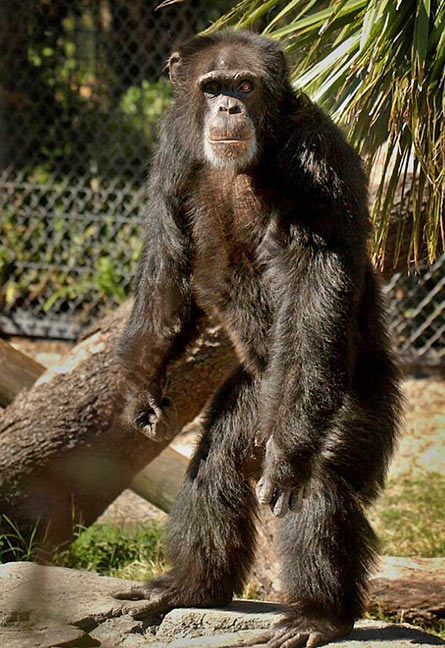 |
|
JANE GOODALL |
St. Pete Times, FLORIDIAN Section E. Dec. 6, 2007 - Zoo Story -
Life. Death. The Paradox of Freedom, Ch. 3 - Imperfect Love |
|
Below:
March 22, 2005, Tampa
- World-renowned primatologist Dr. Jane Goodall speaks with
members of the press while clutching Mr. H, a stuffed toy given to
Goodall in 1996 by friend Gary Haun. |
|
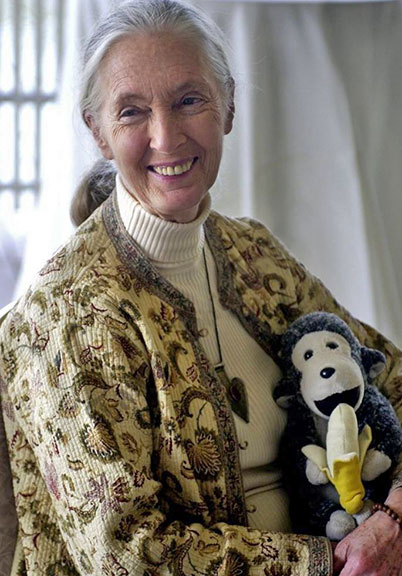
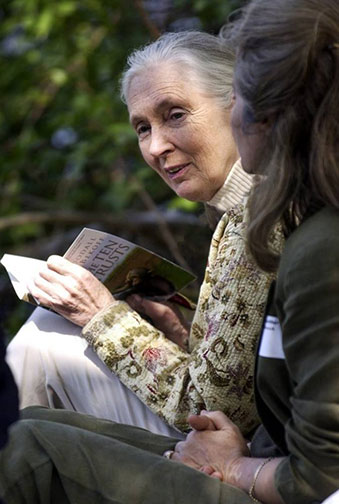
Mar. 21, 2005 -
World-renowned primatologist Dr. Jane Goodall signs copies of her
book, "The Ten Trusts," for Naples resident Heather Burch, while
sitting on the banks near the water outside the A La Carte Pavilion
on Tuesday,
Goodall was the keynote speaker at the
4th Annual Women of Distinction Luncheon held at the A La Carte
Pavilion on Tuesday. The luncheon, which benefited the Girl Scouts
of Suncoast Council, Inc., honored Sally Lowry Baldwin, a Founding
Chair of the Lowry Park Zoological Society, Dr. Karen Brown Dunlap,
president of the Poynter Institute for Media Studies, Ruth Binnicker
Eckerd, chair of the Eckerd family Foundation, and Dorothy S.
Mitchell, a Pasco County philanthropist and former member of the
first all-woman School Board in Pasco County. (Times Photos by Keri
Wiginton) |
|
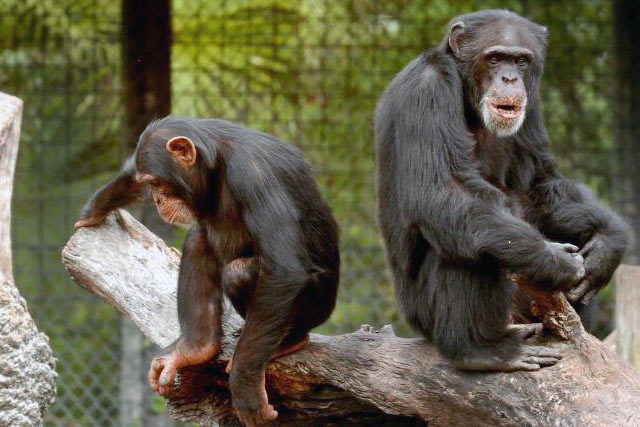 MORTAL
COMBAT MORTAL
COMBAT
The fight appeared to be a struggle for dominance, common in the socially
complex chimp world. They have a strict hierarchal order. Females ally with
males, who fight to establish their rank within the group. Herman, and Bamboo,
who was 44, were the only adult male chimps at Lowry Park Zoo. There was an
adolescent male, Alex, 8, who was 'totally confused' by the fight, said
David Murphy, the zoo's veterinarian who worked at the zoo since 1986. There
were also three females, Jamie, Rukiya and Twiggy, although Twiggy was in the night house
when the fight started.
Alex and Herman, TBT Photo |
|
Zookeepers realized Rukiya was
the most intelligent of the zoo's chimps. Herman was the patient leader
who looked out for all the others. Rukiya was more cunning and calculating.
She often stole food from Herman and manipulated his emotions.
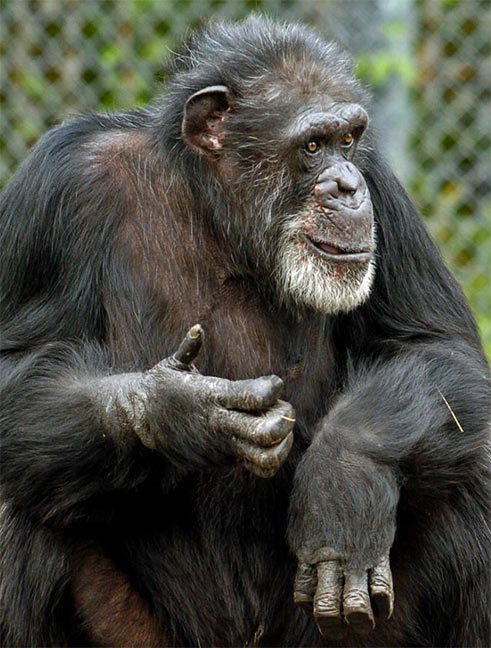
Bamboo, 2005/2006
Tampa Bay Times archives photo courtesy of Kimi Lau-Costanzo.
|
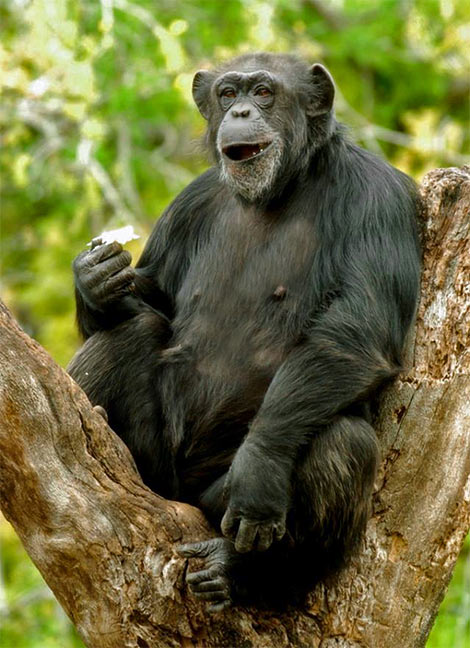
Rukiya, 2005/2006
Tampa Bay Times archives photo courtesy of Kimi Lau-Costanzo.
|
|
Dr. Murphy received an emergency radio call about 12:30
p.m. Thursday, June 8, alerting him to the fight.
He rushed to the habitat, where zoo employees had already sprayed the
chimps with water, which usually quells any kind of disturbance, and ushered the females into the night house.
But that didn't work this time. The males continued to fight and it took another ten minutes to separate the
aggressive males. |
|
Lee Ann Rottman, one of the
primate keepers, happened to be working that day. She and the other
keepers did not witness the start of the fight. But they heard the
commotion, rushed out and saw Bamboo and Rukiya attacking Herman. The chimps were
screaming and their arms were flailing; and Bamboo was chasing Herman and
beating him with his fists. Herman was clearly losing, even as he defended
himself. The keepers tried to break it up. Soon, Herman was on the ground,
sitting cross-legged, slumped over, his head down. He was not
moving, even as Bamboo pounded him. Dr.
Murphy could see that Bamboo was not just upset, but confused and
frightened as well. Murphy tried to dart Bamboo but couldn't get a clear
shot. Once Bamboo moved away, Dr. Murphy and a primate keeper hurried into the exhibit
and dragged Herman into the night house to examine him. He was still
breathing.
Right and below: Bamboo eating romaine
lettuce
Tampa Bay Times archives
photo courtesy of Kimi Lau-Costanzo. 2007 |
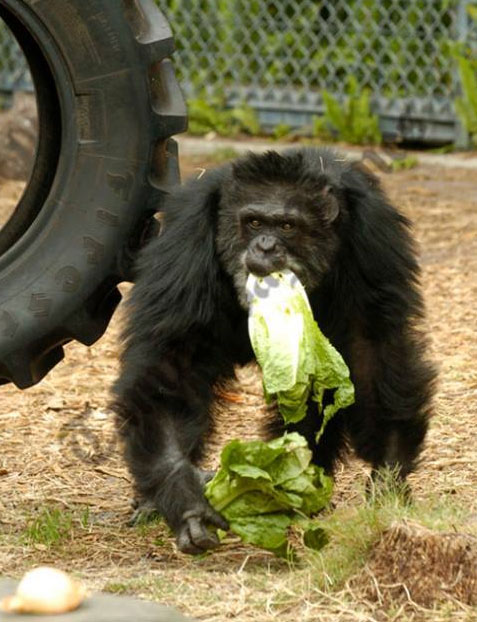 |
|
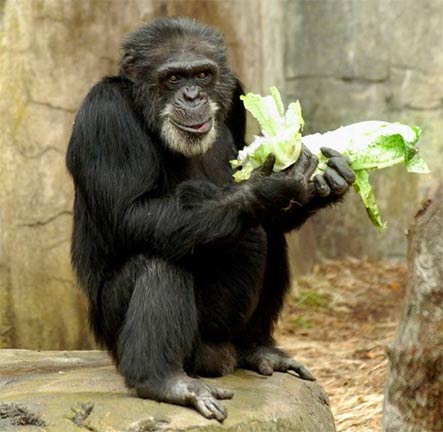 At the clinic, Dr. Murphy examined him more closely, checking Herman for shock, and getting an IV running and
cleaning him up. His external injuries -- a few
puncture wounds on his lip, a torn-up finger and toe -- did not appear
catastrophic. But his pupils and breathing pattern made Murphy wonder whether he
had suffered neurological trauma. As Murphy continued his examination, Rottman
and Angela Belcher, the assistant curator in charge of primates, talked to
Herman, trying to revive him. But he would not wake up; he had slipped into a coma. Leaving the others to watch over Herman, Murphy went
to the zoo's hospital to treat a sedated Rukiya, who was also
injured, requiring stitches. She was expected to fully recover.
Murphy was still
working on her when a call came from the clinic not long before 7 p.m. -- Herman
had stopped breathing. Rushing back, the vet found people taking turns
performing CPR on Herman's 90-pound body. Murphy tried for a while, then Rottman
took over. They
couldn't imagine the zoo or their lives without Herman. Finally though, they had
no other choice. The King was dead. At the clinic, Dr. Murphy examined him more closely, checking Herman for shock, and getting an IV running and
cleaning him up. His external injuries -- a few
puncture wounds on his lip, a torn-up finger and toe -- did not appear
catastrophic. But his pupils and breathing pattern made Murphy wonder whether he
had suffered neurological trauma. As Murphy continued his examination, Rottman
and Angela Belcher, the assistant curator in charge of primates, talked to
Herman, trying to revive him. But he would not wake up; he had slipped into a coma. Leaving the others to watch over Herman, Murphy went
to the zoo's hospital to treat a sedated Rukiya, who was also
injured, requiring stitches. She was expected to fully recover.
Murphy was still
working on her when a call came from the clinic not long before 7 p.m. -- Herman
had stopped breathing. Rushing back, the vet found people taking turns
performing CPR on Herman's 90-pound body. Murphy tried for a while, then Rottman
took over. They
couldn't imagine the zoo or their lives without Herman. Finally though, they had
no other choice. The King was dead.
Zoo
officials closed the exhibit the next day.
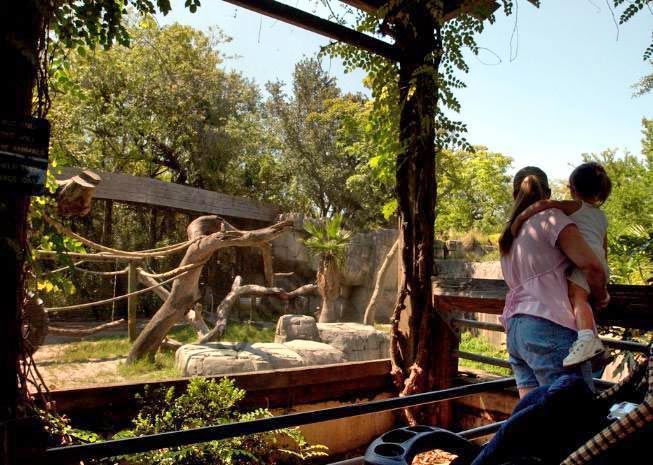
Zoo visitors walk past an empty chimpanzee enclosure.
Tampa Bay Times archives
photo courtesy of Kimi Lau-Costanzo.
The next day, staff members still didn't know what caused Bamboo to
viciously attack his old friend. They were also grieving over the loss of
Herman, one of the zoo's oldest and most colorful characters.
The necropsy report was released
several weeks later. Dr. Murphy found that Herman had died from acute head
trauma and had also suffered from heart disease. The exam also revealed a
clue as the extent of Ruyika's involvement in the attack. Although Bamboo
had beaten Herman severely, it would have been hard for him to inflict the
bites they found on Herman. Bamboo was old and somewhat feeble and virtually had no
teeth. It was one of the reasons he had trouble defending himself when the
females bullied him.
Bamboo and Herman behaved like the best of friends since they were introduced
in 2001, laughing and tickling each other as they played in their exhibit. "Everybody considered them buddies,
they were like two old grandpas
rolling around on the ground together."
The day after Herman's death, the
zoo allowed Ed to say goodbye. Ed felt lost. With tears in his eyes, he
took his hand and kissed Herman's forehead. He spoke softly and called him son.
He told him he missed him and that the two of them would soon be reunited
on the other side. After Herman's death, Ed didn't go to the zoo much
anymore. He couldn't bring himself to look into the chimp exhibit and not
see his friend waiting there for him.
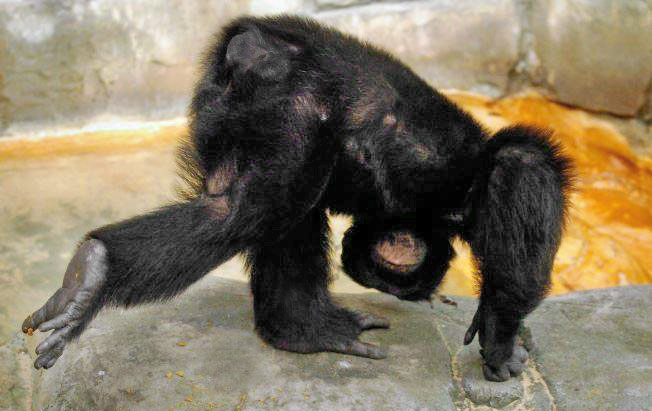
Herman having more fun than a barrel of...
1991
Tampa Bay Times archives
photo courtesy of Kimi Lau-Costanzo.
(Chimps aren't monkeys, they are apes. Monkeys have tails.) |
SOURCES
|
In 2007, author
Thomas French, St. Pete Times, wrote a 9-part series for the
"FLORIDIAN" section of the St. Pete Times titled "Zoo Story - Life.
Death. The Paradox of Freedom."
About the newspaper series: Over the past four years (2003-2007),
St. Petersburg Times staff writer Thomas French and staff
photographer Stefanie Boyar chronicled life inside Tampa's Lowry
Park Zoo. With the zoo's permission, they followed the keepers and
the animals, interviewing everyone from the volunteers to the zoo's
CEO. French and Boyar witnessed most of the events described in this
series. By necessity, though, some scenes were reconstructed.
Today's sections describing how the elephants arrived at Tampa
International and were escorted to Lowry Park are based on
interviews with Mick Reilly in Swaziland, and with Lex Salisbury,
Lee Ann Rottman, Larry Killmar and others at Lowry Park. The scenes
describing the elephants' first days at the zoo are based on
interviews with Brian French and Steve Lefave who were entrusted
with the elephants' care. Brian French is not related to Thomas
French, the Times reporter. The scenes describing the zoo's efforts
to save ailing manatees are based on interviews with David Murphy,
Lowry Park's veterinarian, and Virginia Edmonds and other staff
members. In addition, the Times witnessed the vet and the keepers
working with manatees at the zoo and accompanied the staff on
several manatee releases.
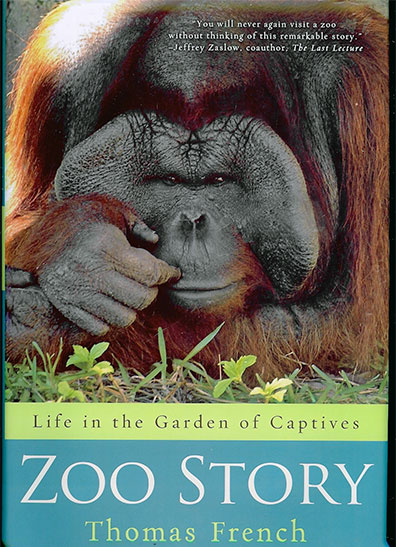
In 2010, French published his book, Zoo Story, Life in the Garden of
Captives. |
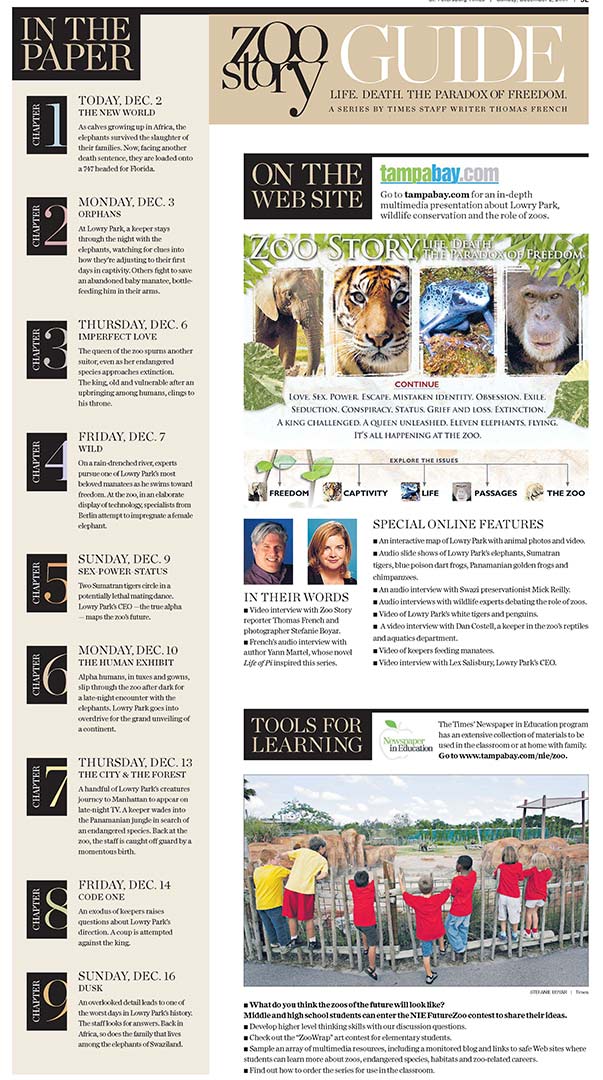 |
|
Don't miss
J. D. (Doug) Porter's interesting blog about
zoos and other related topics.
He is an excellent author and has written quite a
few books.
"From animal keeper to zoo director, my career
spanned over forty years. It included positions with
a half dozen of America’s great zoos during the most
transformational era in zookeeping in more than a
century—a time when zoos went from 19th century
menageries to modern day arks."
Five articles are specifically about his years at
Lowry Park:
A Ride to Remember - Memories of Sheena's
preparation to relocate her in Canada
Apr. 19, 2014
This Place is a Zoo, Chapter 5 - Although this
bears the same name as a post on his blog, this one
is an excerpt from his book: This Place is a Zoo:
How thinking of your workplace as a zoo might make
you a better manager, by J. D. Porter. There is a
paragraph about Herman and another one about his new
home after the renovation.
Good Sized Zoo for the City of Tampa - A brief
history of Tampa's zoos.
Nov. 7, 2019
Bringing Down the Bars - Doug Porter and his
time in Tampa during Lowry Park Zoo's transition of
1984.
Nov. 18, 2019
An Elephant Moves to Canada - Sheena, from
beginning to end.
Nov. 27, 2019
Tampa's Lowry Park Chimps Walk on Grass - The
story of Herman and Gitta from Liberia to Lowry
Park.
Dec. 5, 2019 |
|
The image of
Herman in the Rainbow Bridge header art for this page comes
from the painting at right by Said Swayssi, courtesy of Trend
Hunter Art & Design, "Creative
Critter Art" where it says:
The Animalistic Art of Said Swayssi is Cute and Impressive
By Armida Ascano - Sep 20, 2010 Updated: Jun 22 2011
Said Swayssi is an imaginative artist who recently released a
series entitled 'Ecographie.' The series depicts animals in
hilarious poses, such as smoking a pipe or dressed in a
military outfit. The series speaks on Said Swayssi's skill and
ability to think outside the box. Said Swayssi aims to speak
on the animalistic tendencies of human beings, as a few humans
are sprinkled throughout the work as well. |
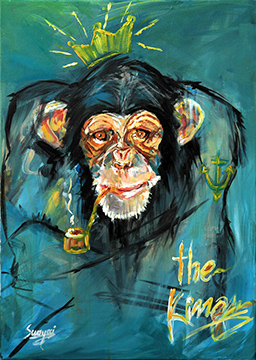 |
|
|
 |
|
2006 - Aug. - Lowry Park Zoo
president and chief executive Lex Salisbury, left, general curator
Lee Ann Rottman, veterinarian Dr. David Murphy and zoo board member
Bill Blanchard answer questions about a tiger which escaped from its
night house Tuesday evening and was killed.
STORY SUMMARY: Press conference at Lowry Park Zoo after Enshala, a
Sumatran tiger, escaped her night house on Tuesday and was killed by
zoo president and chief executive Lex Salisbury. An unlocked latch
allowed the tiger to roam into a nearby exhibit still under
construction.
8/22/2006 Tampa Bay Times
archives photo courtesy of Kimi Lau-Costanzo. |
Story and photo sources:
Tampa's Lowry Park Chimps Walk on Grass - The story
of Herman and Gitta from Liberia to Lowry Park, by J. D.
"Doug" Porter,
Dec. 5, 2019
This Place is a Zoo - by Doug Porter, Sept. 14, 2015
St. Pete Times FLORIDIAN Section
E, Dec. 10, 2007 Zoo
Story - Chapter 6 "The Human Exhibit,
Zoo Story, 2010 Chapter 12 "Undertow"
Zoo Story, 2007 Chapter 1 Code One
Zoo
Story, Dec. 2007 Guide
Florida Parent-Educators Assoc. (FPEA) Animal Story - Blog
Requiem For Royal Duo
October 2, 2006 By Thomas French, St. Petersburg Times
Zoo Story - Life in the Garden of Captives, Google
books
Home is Where the Boat Is.net Sept. 2010 - Zoo Story
St. Pete Times, FLORIDIAN Section E. Dec. 6, 2007 - Zoo Story - Ch.
3 - Imperfect Love
One minute, harmony; the next, chimp mayhem
St. Petersburg
Times - Weimar, Carrie Date: Jun 10, 2006
|
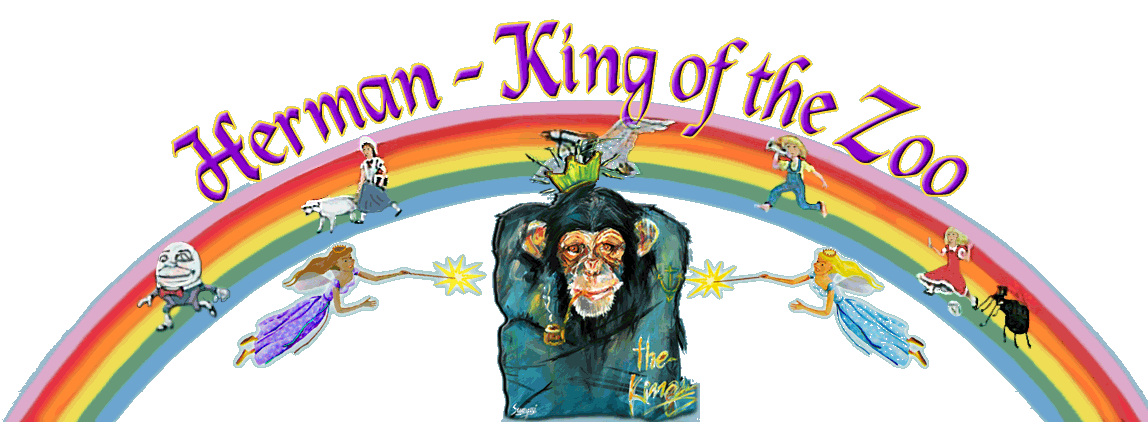
 EARLY
LIFE
EARLY
LIFE 





 Tampa newspaper photographers took pictures of Mayor Dick
Greco hamming it up with the chimps. One shot showed them seated beside
Greco, pondering the city budget. The staged frivolity didn't take
away the bittersweet emotions of the day, but the Schultzes were pleased
to see Herman reveling in the spotlight. That day, as he posed for
the news crew, he was being trained to perform for a larger audience.
For better or worse, he was about to become a star.
Tampa newspaper photographers took pictures of Mayor Dick
Greco hamming it up with the chimps. One shot showed them seated beside
Greco, pondering the city budget. The staged frivolity didn't take
away the bittersweet emotions of the day, but the Schultzes were pleased
to see Herman reveling in the spotlight. That day, as he posed for
the news crew, he was being trained to perform for a larger audience.
For better or worse, he was about to become a star.

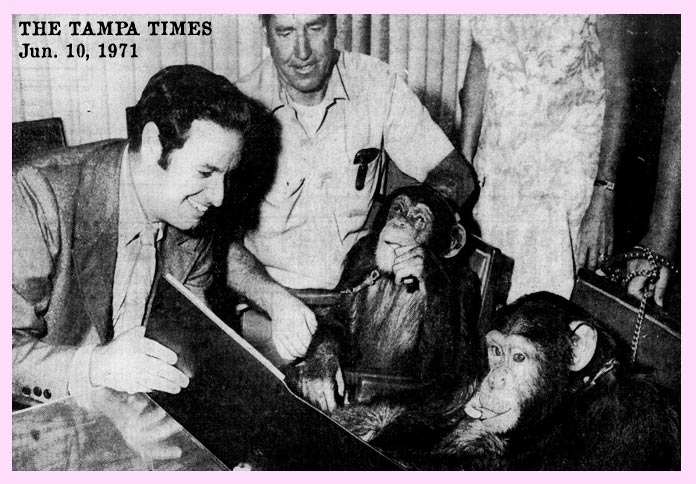
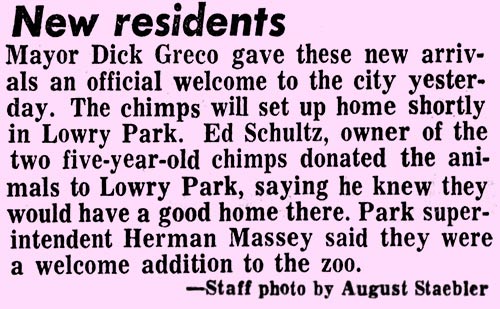


 Twelve
years after the newspaper article that linked us, Herman and I
would cross paths again when a master plan called for a new zoo,
and I was hired to guide the process. For nearly three years,
workers poured concrete, sculpted artificial rocks, and installed
caging until we were planting grass, testing waterfalls, and
moving animals into their new homes. The new chimpanzee area was
not especially large, but it was an interesting and varied space
for animals who had only known concrete and chain-link. A long,
grassy yard was broken up by large logs and an artificial,
concrete termite mound. A deep dry-moat barrier afforded the
chimps an unobstructed view of their human visitors and the
landscape beyond. One of the highlights of my zoo career was
seeing Herman walk on grass for the first time and climb atop his
favorite perch on the termite mound to gaze back at me. I am not
suggesting that he was actually “happy” but I do know that I did
everything in my power to make him so.
Twelve
years after the newspaper article that linked us, Herman and I
would cross paths again when a master plan called for a new zoo,
and I was hired to guide the process. For nearly three years,
workers poured concrete, sculpted artificial rocks, and installed
caging until we were planting grass, testing waterfalls, and
moving animals into their new homes. The new chimpanzee area was
not especially large, but it was an interesting and varied space
for animals who had only known concrete and chain-link. A long,
grassy yard was broken up by large logs and an artificial,
concrete termite mound. A deep dry-moat barrier afforded the
chimps an unobstructed view of their human visitors and the
landscape beyond. One of the highlights of my zoo career was
seeing Herman walk on grass for the first time and climb atop his
favorite perch on the termite mound to gaze back at me. I am not
suggesting that he was actually “happy” but I do know that I did
everything in my power to make him so.




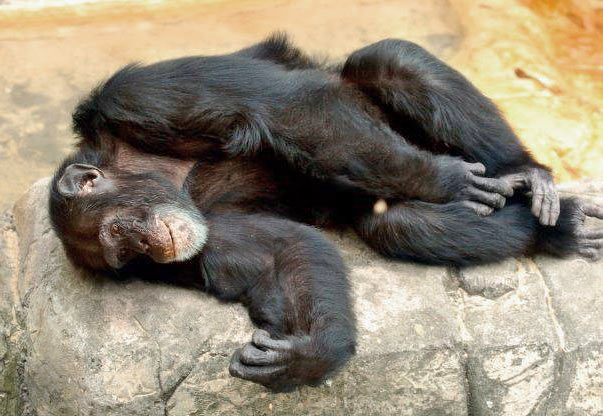
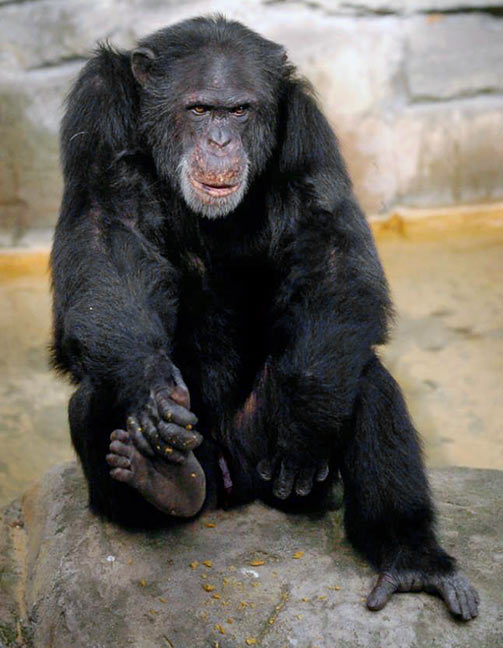 .
.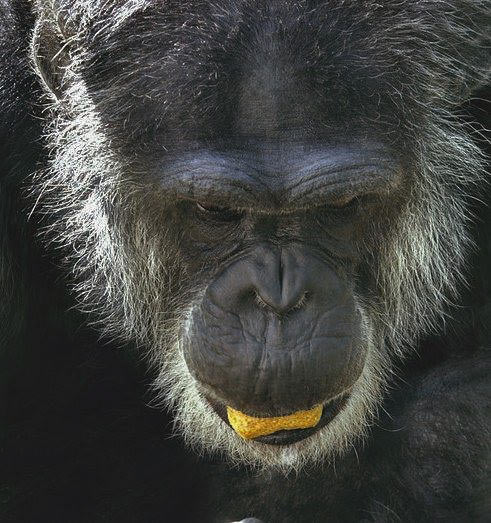
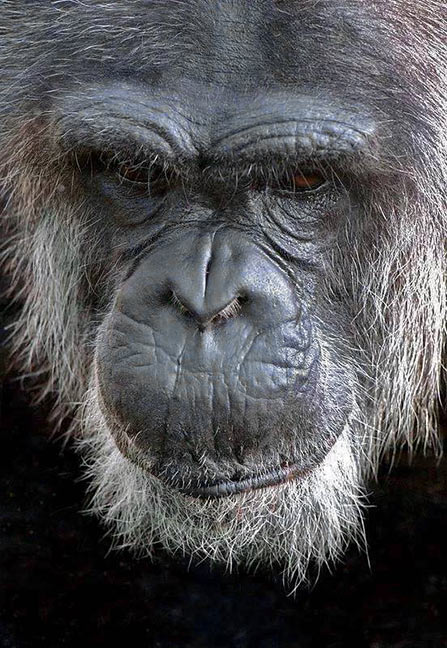
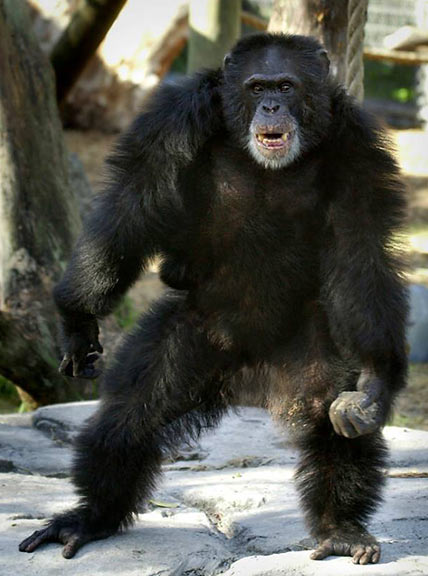
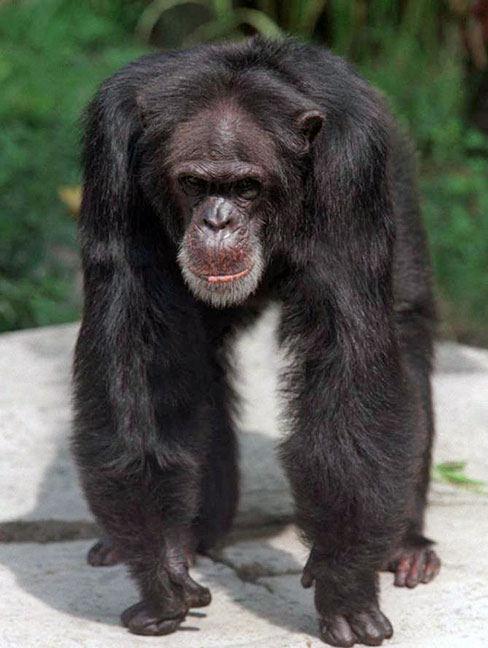










 At the clinic, Dr. Murphy examined him more closely, checking Herman for shock, and getting an IV running and
cleaning him up. His external injuries -- a few
puncture wounds on his lip, a torn-up finger and toe -- did not appear
catastrophic. But his pupils and breathing pattern made Murphy wonder whether he
had suffered neurological trauma. As Murphy continued his examination, Rottman
and Angela Belcher, the assistant curator in charge of primates, talked to
Herman, trying to revive him. But he would not wake up; he had slipped into a coma. Leaving the others to watch over Herman, Murphy went
to the zoo's hospital to treat a sedated Rukiya, who was also
injured, requiring stitches. She was expected to fully recover.
Murphy was still
working on her when a call came from the clinic not long before 7 p.m. -- Herman
had stopped breathing. Rushing back, the vet found people taking turns
performing CPR on Herman's 90-pound body. Murphy tried for a while, then Rottman
took over. They
couldn't imagine the zoo or their lives without Herman. Finally though, they had
no other choice. The King was dead.
At the clinic, Dr. Murphy examined him more closely, checking Herman for shock, and getting an IV running and
cleaning him up. His external injuries -- a few
puncture wounds on his lip, a torn-up finger and toe -- did not appear
catastrophic. But his pupils and breathing pattern made Murphy wonder whether he
had suffered neurological trauma. As Murphy continued his examination, Rottman
and Angela Belcher, the assistant curator in charge of primates, talked to
Herman, trying to revive him. But he would not wake up; he had slipped into a coma. Leaving the others to watch over Herman, Murphy went
to the zoo's hospital to treat a sedated Rukiya, who was also
injured, requiring stitches. She was expected to fully recover.
Murphy was still
working on her when a call came from the clinic not long before 7 p.m. -- Herman
had stopped breathing. Rushing back, the vet found people taking turns
performing CPR on Herman's 90-pound body. Murphy tried for a while, then Rottman
took over. They
couldn't imagine the zoo or their lives without Herman. Finally though, they had
no other choice. The King was dead. 




